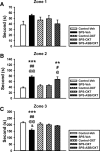Effects of oxytocin on prosocial behavior and the associated profiles of oxytocinergic and corticotropin-releasing hormone receptors in a rodent model of posttraumatic stress disorder
- PMID: 30898126
- PMCID: PMC6427848
- DOI: 10.1186/s12929-019-0514-0
Effects of oxytocin on prosocial behavior and the associated profiles of oxytocinergic and corticotropin-releasing hormone receptors in a rodent model of posttraumatic stress disorder
Abstract
Background: Traumatic experience may lead to various psychological sequelae including the unforgettable trauma-associated memory as seen in posttraumatic stress disorder (PTSD), with a mechanism of impaired fear extinction due to biological imbalance among hypothalamic-pituitary-adrenal (HPA) axis and fear circuit areas such as medial prefrontal cortex (mPFC), hippocampus, and amygdala. Recently the impaired sociability seen in PTSD patients received great attention and the involvement of oxytocin (OXT) mediation is worth being investigated. This study examined whether the trauma-altered prosocial behavior can be modulated by OXT manipulation and its relationship with corticotropin-releasing hormone (CRH) signaling.
Methods: Male rats previously exposed to a single prolonged stress (SPS) were evaluated for their performance in social choice test (SCT) and novel object recognition test (NORT) following the introduction of intranasal oxytocin (OXT) and OXT receptor antagonist atosiban (ASB). OXT receptors (OXTR) and CRH receptors (CRHR1, CRHR2) were quantified in both protein and mRNA levels in medial prefrontal cortex (mPFC), hippocampus, and amygdala.
Results: SPS reduced inclination of rats staying at the sociable place with performing less prosocial contacts. OXT can amend the deficit but this effect was blocked by ASB. Expression of OXTR became reduced following SPS in mPFC and amygdala, the latter exhibited higher therapeutic specificity to OXT. Expression of CRHR1 appeared more sensitive than CRHR2 to SPS, higher CRHR1 protein levels were found in mPFC and amygdala.
Conclusion: Psychological trauma-impaired sociability is highly associated with OXT signaling pathway. Intranasal OXT restored both the SPS-impaired prosocial contacts and the SPS-reduced OXTR expressions in mPFC and amygdala. OXT may have therapeutic potential to treat PTSD patients with impaired social behaviors.
Keywords: Corticotropin-releasing hormone; Fear circuit areas; Oxytocin; Posttraumatic stress disorder, Prosocial behavior, Single prolonged stress..
Conflict of interest statement
The authors declare that they have no competing interests.
Figures







Similar articles
-
Effects of Oxytocin on Fear Memory and Neuroinflammation in a Rodent Model of Posttraumatic Stress Disorder.Int J Mol Sci. 2018 Dec 3;19(12):3848. doi: 10.3390/ijms19123848. Int J Mol Sci. 2018. PMID: 30513893 Free PMC article.
-
Acute Restraint Stress Enhances Prosocial Behavior in Rats via Oxytocin and Fear-Related Circuits.J Integr Neurosci. 2025 Apr 3;24(4):33400. doi: 10.31083/JIN33400. J Integr Neurosci. 2025. PMID: 40302260
-
Oxytocin receptor is a potential biomarker of the hyporesponsive HPA axis subtype of PTSD and might be modulated by HPA axis reactivity traits in humans and mice.Psychoneuroendocrinology. 2021 Jul;129:105242. doi: 10.1016/j.psyneuen.2021.105242. Epub 2021 May 3. Psychoneuroendocrinology. 2021. PMID: 33975150
-
The Oxytocin Receptor: From Intracellular Signaling to Behavior.Physiol Rev. 2018 Jul 1;98(3):1805-1908. doi: 10.1152/physrev.00031.2017. Physiol Rev. 2018. PMID: 29897293 Review.
-
Genetics of glucocorticoid regulation and posttraumatic stress disorder--What do we know?Neurosci Biobehav Rev. 2016 Apr;63:143-57. doi: 10.1016/j.neubiorev.2016.02.005. Epub 2016 Feb 9. Neurosci Biobehav Rev. 2016. PMID: 26872620 Review.
Cited by
-
Contrasting Effects of Oxytocin on MK801-Induced Social and Non-Social Behavior Impairment and Hyperactivity in a Genetic Rat Model of Schizophrenia-Linked Features.Brain Sci. 2024 Sep 13;14(9):920. doi: 10.3390/brainsci14090920. Brain Sci. 2024. PMID: 39335415 Free PMC article.
-
HIV-1 Tat and morphine decrease murine inter-male social interactions and associated oxytocin levels in the prefrontal cortex, amygdala, and hypothalamic paraventricular nucleus.Horm Behav. 2021 Jul;133:105008. doi: 10.1016/j.yhbeh.2021.105008. Epub 2021 Jun 23. Horm Behav. 2021. PMID: 34171549 Free PMC article.
-
Identification of the Similarities and Differences of Molecular Networks Associated With Fear Memory Formation, Extinction, and Updating in the Amygdala.Front Mol Neurosci. 2021 Dec 2;14:778170. doi: 10.3389/fnmol.2021.778170. eCollection 2021. Front Mol Neurosci. 2021. PMID: 34924954 Free PMC article.
-
H2S and Oxytocin Systems in Early Life Stress and Cardiovascular Disease.J Clin Med. 2021 Aug 6;10(16):3484. doi: 10.3390/jcm10163484. J Clin Med. 2021. PMID: 34441780 Free PMC article.
-
Oxytocin Signaling as a Target to Block Social Defeat-Induced Increases in Drug Abuse Reward.Int J Mol Sci. 2021 Feb 27;22(5):2372. doi: 10.3390/ijms22052372. Int J Mol Sci. 2021. PMID: 33673448 Free PMC article. Review.
References
-
- American Psychiatric Publishing I. Diagnostic and statistical manual of mental disorders. 5th ed: American Psychiatric Association; 2013.
-
- Heinrichs M, Baumgartner T, Kirschbaum C, Ehlert U. Social support and oxytocin interact to suppress cortisol and subjective responses to psychosocial stress. Biol Psychiatry. 2003;54(12):1389–1398. - PubMed
-
- Neumann ID, Landgraf R. Balance of brain oxytocin and vasopressin: implications for anxiety, depression, and social behaviors. Trends Neurosci. 2012;35(11):649–659. - PubMed
MeSH terms
Substances
Grants and funding
LinkOut - more resources
Full Text Sources
Medical

